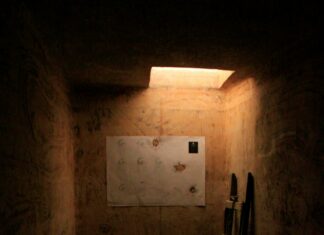Ian Wood, a wildlife photographer from the UK, clinched the prestigious People’s Choice Award at the Wildlife Photographer of the Year contest with his captivating image titled “No Access.” The photograph features a Eurasian badger, bathed in the glow of a streetlight, seemingly gazing up at badger graffiti adorning a serene road in St Leonards-on-Sea, England.
Wood’s winning composition stood out among 25 finalists, garnering a record number of votes from over 76,000 individuals. The inspiration behind the snapshot stemmed from Wood’s observation of badgers feasting on food scraps left by locals, prompting him to set up a hide to capture the perfect shot. The image portrays the badger turning its head, possibly in puzzlement at the painted representation of its kind on the nearby wall.
Delighted by the positive response to his work, Wood expressed a deeper hope that his endearing photograph would shed light on the challenges faced by urban badgers, particularly in the context of the ongoing badger cull. Residing in rural Dorset, Wood is on a mission to boost wildlife habitats and raise awareness about the adverse impact of the cull on badger populations. He emphasized the urgency of halting the cull to prevent the extinction of badgers in many parts of England.
Dr. Douglas Gurr, the director of the Natural History Museum, which hosts the competition, commended Wood’s image for showcasing the harmonious co-existence between urban wildlife and human environments. Gurr highlighted the importance of understanding and appreciating urban wildlife, with Wood’s photograph serving as a poignant reminder of the captivating nature that surrounds us, often just beyond our doorstep.
Highly Commended Images
Aside from Wood’s winning entry, the Wildlife Photographer of the Year contest also recognized four highly commended images that resonated with the public. Francisco Negroni’s mesmerizing photograph titled “Earth and Sky” captures a double lenticular cloud illuminated by the lava emanating from Chile’s Villarrica volcano. Negroni’s dedication to monitoring the volcano’s activity led to this striking image, which juxtaposes the natural beauty of the cloud formation with the fiery spectacle of the volcano.
Another standout entry, “Edge of Night” by Jess Findlay, features a ghostly barn owl emerging from a dilapidated barn in Vancouver, Canada, to hunt in the moonlit fields. Findlay’s meticulous planning and patience culminated in this ethereal image, capturing the owl’s graceful flight against a backdrop of softly illuminated clouds and the rustic charm of the barn.
David Northall’s powerful image titled “Spiked” documents a fierce encounter between a honey badger and a Cape porcupine in Botswana. The photograph chronicles the relentless pursuit of the honey badger as it overcomes the porcupine’s defenses to secure its prey, illustrating the raw intensity of survival in the wild.
Lastly, Michel d’Oultremont’s photograph “Whiteout” portrays a stoat blending seamlessly into a snowy landscape in Belgium, showcasing the creature’s remarkable camouflage. D’Oultremont’s patience and dedication to capturing the stoat in its natural habitat resulted in a visually captivating image that celebrates the stoat’s adaptability to its wintry surroundings.
In conclusion, the Wildlife Photographer of the Year contest celebrates the beauty and diversity of the natural world through the lens of talented photographers like Ian Wood and the highly commended artists. These captivating images serve as a testament to the intricate relationship between wildlife and their environments, inspiring viewers to appreciate and protect the wonders of the animal kingdom.





































































